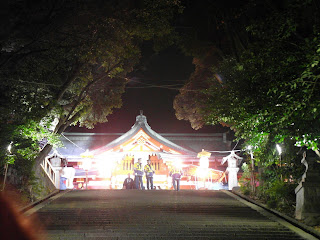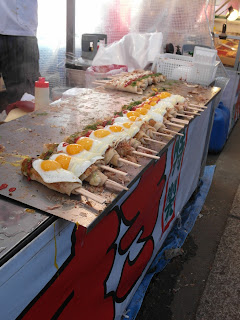あけましておめでとう!
Happy New Year! Last year, Blammo and I searched for a traditional countdown party-like atmosphere with disappointing results. This year, Blammo's family was in town, so we did what all the other people in Japan do - we went to a shrine.
The New Year's holiday is arguably the most important and busy holidays of the year in Japan just like Lunar New Year in China and Tết in Vietnam. O-shogatsu follows a lot of the same traditions, but is celebrated during the Gregorian New Year. Offices close around December 29th until around January 3rd so that everyone can return home to their respective towns and celebrate the new year festivities with their family. Depending on how you look at it, it's a great time to visit Tokyo. It's very peaceful but on the other hand, most shops are closed.
We went to Hie Jinja Shrine near our apartment after a delicious sushi dinner. We arrived around 11pm but the shrine was still setting up. Hatsumode is the most important aspect of o-shogatsu and it refers to the first prayer of the year. Many people visit the shrines around midnight on December 31st because being one of the first to pray brings good luck. Since we got there so early, we were in the front of the line to ring in the new year.
Around 11:30pm, the line was pretty long. There were police officers manning the scene to lay down the law (don't push, go slowly and exit to the right). There was a lot of bumping and pushing but it was all harmless and probably due to drunkeness. It may be taboo to show up drunk to midnight mass, but it's almost expected that you show up tipsy to a shrine on New Year's. In fact, the shrines sell beer and sake on sight. It's a great time to try warm sweet milky sake called amazake.
When the clock struck midnight, everyone clapped and yelled "akemashite omedetou!" which literally means, congratulations on the opening. Pro tip - in English, we say "Happy New Year" both before and after December 31st. Not so in Japanese. You say "yoi otoshi o" before the New Year and "akemashite omedetou gozaimasu" after. I've confused a lot of people by mixing them up and am grateful that someone finally corrected me.The gates opened at midnight to let everyone in to pray. At shinto shrines, you clap twice, bow, throw money into a wooden box, pray and ring a bell. The order is still a little fuzzy to me, but that's the gist of it. On New Year's, monks strike a large gong 108 times so that was going down in the background. I have to say, it was a pretty deep experience and I preferred this spiritual celebration much more than your typical get wasted party/fight for a taxi home.
This being Japan, there was plenty of good fortune to be purchased from pretty young shrine maidens. The most popular on New Years is a hamaya which means "demon breaking arrow".
When placed in your home, the arrow will ward of evil spirits for the year. A whole year's worth of protection for $16, plus cute bells and a picture of a rabbit? Done.
An interesting fact that will either make you look smart or like a jerk depending on how you present it: In the Vietnamese Zodiac calendar, the year of the rabbit is actually the year of the cat. The word for "rabbit" in Chinese sounds a lot like the word for "cat" in Vietnamese, thus the mistranslation. So this year is both the year of the cat and rabbit, depending on where you are.
Your omikuji also goes into length about travel, romance, lost items, law suits, examinations, business and health. According to my fortune, my lost items will be returned and I will win a law suit this year. It also said that I if I consult others about my problems, I will have a good year.
You can also buy a daruma, the red doll shown above. These are little dream catchers. You set a goal and fill in the right eye and when you accomplish your goal, you fill in the left eye.
And of course, there's incredible food during o-shogatsu! Typically, families eat very special bentos (osechi ryori) on New Years. They're very symbolic but according to my friend, not that tasty. She was a little late to pick me up from the train station because she had to buy some bread - they were tired of eating Japanese food! We visited one of her local shrines, Hikawa Jinja in Omiya. It is the largest shrine in Saitama and also the 8th most popular during the new year. (Meiji-jingu in Harajuku is #1) It was indeed very crowded, but the food was INSANE! I was wearing a very expensive kimono that didn't belong to me, so I couldn't really get down on it, but it looked great. Lots of fried and grilled meats covered in butter, eggs, mayonaise and salt. If your new year's resolution is to eat better, this is not the place to visit.
Monjayaki on a stick with a fried egg on top. It's not clear to me how you eat this, but I definitely would have ruined my friend's mom's kimono had I tried to figure it out.
Grilled fish on a stick.
Mini okonomiyaki
Takoyaki with a whole mini-octopus inside.
Grilled potatoes with butter
The 7 spices that make up shichimi. Chili pepper, mikan peel, white sesame, black sesame, hemp powder, ginger and seaweed.
Our big souvenir of the day was a personalized blend of shichimi. I like to put shichimi on everything. Plain rice, chicken meatballs, soup, noodles etc. At this stand, you tell the spice guy what you like and he makes a special blend just for you. Blammo likes spicy so he asked for a very spicy Blammo blend and the man did not disappoint. As much fun as all the talismen and fortunes are, this is a nice practical souvenir to remember our first traditional oshogatsu.


















Where's the picture of the KIMono?
ReplyDeletehttp://www.flickr.com/photos/13737757@N04/5319152853/
ReplyDeleteI'm so happy you REED my blog.